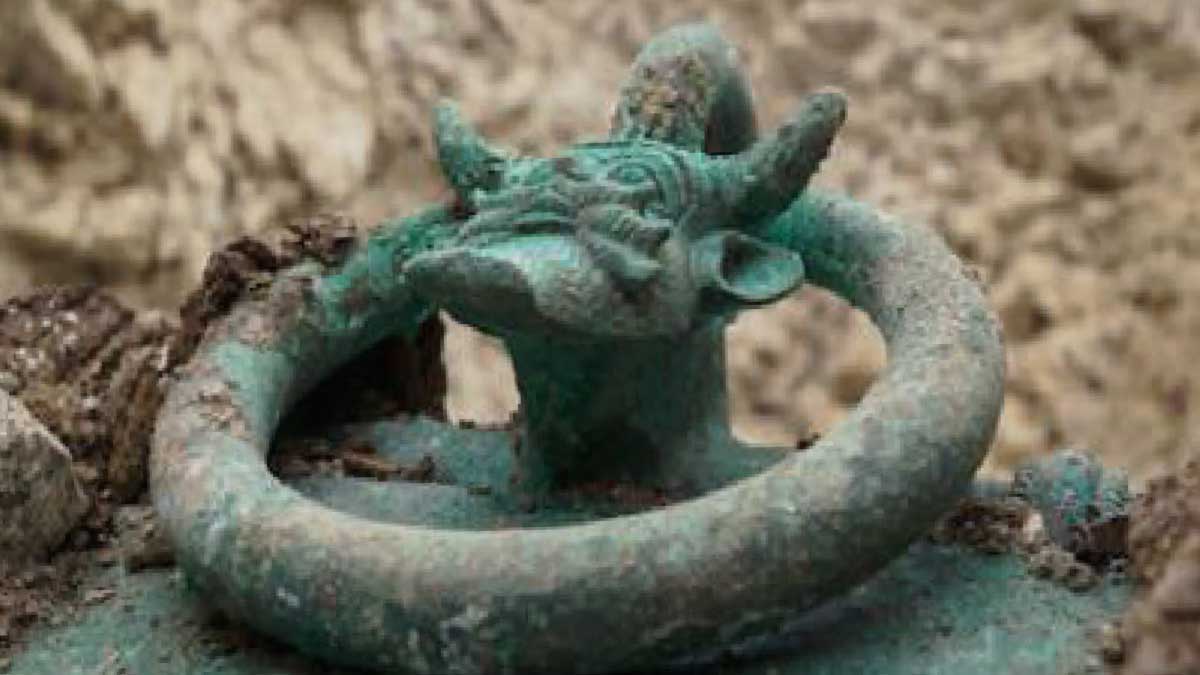Celtic Craftsmanship: Iron Age Chariot Fitting Unearthed

In the heart of a landscape rich with Celtic tradition, archaeologists have made a remarkable discovery: a bronze chariot fitting dating back to the 3rd–2nd century BCE. Circular in design and adorned with a striking bull-head motif, this artifact bridges the gap between utility and symbolism, reminding us how objects of war and transport in the Iron Age were also works of art.

The chariot fitting, with its deep green patina formed over centuries underground, remains impressively intact. Its durability reflects not only the quality of Celtic metalworking but also the ritual importance such objects carried. To the Iron Age Celts, a chariot was more than a vehicle of speed or power—it was a symbol of status, warfare, and divine connection. Ornamental fittings like this one showcased the owner’s prestige while invoking protective or spiritual associations through their intricate designs.
The choice of a bull motif is especially significant. Across Celtic culture, the bull was a powerful symbol of strength, fertility, and dominance. Bulls featured prominently in mythology, rituals, and even sacrifices, often tied to themes of abundance and cosmic balance. To adorn a chariot with a bull’s head was to channel these qualities, turning a functional vehicle into a moving emblem of authority and sacred symbolism.

Such artifacts also reflect the mastery of Celtic metalworkers. Iron Age craftsmanship combined utility with beauty, ensuring even everyday tools and fittings carried aesthetic and symbolic weight. The flowing curves and careful detailing reveal a society where artisanship was deeply valued, and where objects were designed not only for function but also for storytelling and spiritual resonance.
Chariots themselves played a central role in Iron Age life. They were not merely modes of transport; they were instruments of warfare, ceremonial display, and elite identity. Warriors rode them into battle to intimidate foes, while leaders used them to display wealth and divine favor. In some burials, entire chariots were interred with their owners, demonstrating their role as companions in both life and the afterlife. Discoveries like this fitting offer direct evidence of that intersection between the martial, the ceremonial, and the spiritual.

From a broader perspective, this artifact deepens our understanding of the Celtic worldview. The Celts saw little separation between the material and the mythic. Everyday life was infused with ritual meaning, from decorated pottery to weaponry, from jewelry to chariot fittings. Each artifact was part of a larger narrative—one in which human life, nature, and the divine were intertwined.
For modern audiences, the newly uncovered fitting is more than just a relic. It is a tangible link to a people who lived over two millennia ago, whose artistry and beliefs continue to inspire fascination. Holding such an object—or even seeing it displayed—reminds us of the continuity of human creativity and the enduring need to weave beauty and meaning into tools of survival and power.
This Iron Age chariot fitting, adorned with its proud bull’s head, is not just a fragment of metal. It is a symbol of Celtic identity, resilience, and imagination—a reminder that even in war, artistry and myth traveled side by side.
#CelticHeritage #IronAge #ArchaeologyFinds #AncientCraftsmanship #CelticMystery











